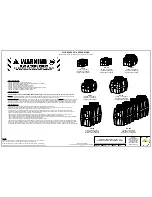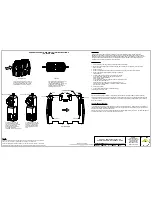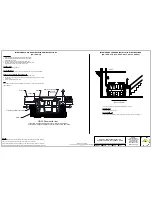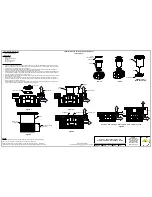
Striem
3100 Brinkerhoff
Kansas City, KS 66115
Tel: 913-222-1500
Fax: 913-291-0457
www.
striemco.com
Made in the U.S.A
Adapter
Adapter
Cover
Cover
Gasket
Gasket
OS-100
(standard)
Upper clamp
Lower clamp
Lower clamp
Upper clamp
Cut location "C"
LR24
(long riser)
(optional component)
Gasket
Upper Clamp
Lower Clamp
Cut location "B"
SR24
(short riser)
(optional component)
Gasket
Lower Clamp
Upper Clamp
OS-35, OS-50,
OS-75 & OS-100
(standard)
Adapter
Cover
Gasket
Upper clamp
Lower clamp
VENT
FLOW
Finished floor
Figure 1
Riser Height
Adapter
Unit
Figure 2
Adapter
Riser
Riser
Distance from step 5
4"
Cut
Mark
Figure 3
Adapter
Riser
exceed 4"*
Must be at least
2-1/2" and cannot
Gasket
Unit
Riser/Adapter
Upper Clamp
Lower Clamp
Figure 4
*3" for a OS-35 with 4" connections
5. Adjust
adapter
upwards to reach 20" to 22"
6. Adjust
adapter
upwards to reach 35" to 37"
Cut location "A"
Adapter
Cover
Adapter & Cover
(standard component)
Tools included (with base grease interceptor unit(s))
7/16" Nut driver tool/bit
•
Silver permanent marker
•
Tools Needed:
Tape measure
•
Regular or cordless drill with 1/2" chuck
•
Tools needed if Riser(s) require cutting:
Jigsaw or
•
Cordless circular saw or
•
Reciprocating saw
•
Riser Assembly Instructions/Steps:
If unit is to be installed on grade (on-the-floor), there is no need for any adjustments.
1.
Unit is ready to be put into service.
If unit is to be buried: Once unit is set so that the pipe connections line up with
2.
jobsite piping, measure total riser height needed from top of cover to finished
grade. Make sure you include any future tile work, etc. that may be installed
in your finished grade measurements. See figure 1.
Select according riser(s) needed based off Table 1.
3.
If riser(s) is needed, remove cover(s) from adapter and remove adapter from main
4.
unit by loosening upper clamp with included nut driver bit (lower band is factory
set do not adjust or remove). On the floor near the unit, insert adaptor into first riser
until it stops. If needed, insert bottom of first riser into top of second riser until it stops.
You may need to tighten upper clamps during this step to keep risers from shifting.
Adapter and riser(s) should sit level with each other. Removal of cover during this process
will ease assembly.
From the top of the adapter, measure your needed total riser height downward to the
5.
sidewall of the riser. Then, add
5”
(for OS-35 or OS-50) or
6”
( for OS-75, or OS-100).
For example, if you have a OS-100 and need a 15-1/2” extension, you would measure
down from the top of the adapter 21-1/2” (15-1/2” + 6” = 21-1/2”). See Figure 2.
Refer to Table 2, Table 3 or Table 3a to determine if, and where, any cuts need to be made.
6.
If a cut needs to be made, make a circular line around the sidewall of the riser with the
included silver marker at your riser height
+dimension from step 5
. Using a jigsaw, circular
saw or reciprocating saw, cut along your line. Discard/recycle the cutoff scrap.
Whether the riser needs to be cut or not, make another mark with the silver marker on the
7.
sidewall of the riser a distance of
4 INCHES
(3 INCHES for a OS-35 w/ 4” connections) above
the edge just cut. If you did not make a cut (meaning your riser height
+ dimension from
step 5
line was beyond the bottom edge of your riser), still mark the sidewall of the riser
4 INCHES above where your riser height
+ dimension from step 5
line would have been.
DO NOT cut this new line. Once the riser is installed into the main unit, this new line will end
up at the top of the gasket and will aid in re-assembly. See Figure 3.
IMPORTANT: Before the next step:
8.
Make sure both diffusers are installed inside the main unit at the appropriate locations
and check if there needs to be any flow control adjustment on the inlet diffuser. Refer
to sheet 2 of the installation instructions for flow control adjustment.
Refer to sheet 1 of the installation instructions for leak/water testing procedures.
9.
Take riser(s) and adapters apart to reduce the weight during installation. Wipe all sidewalls and
10.
inside of gasket with a damp cloth to remove jobsite dust/debris. Install components into the main
unit starting from the lowest (cut) riser and working your way toward the finished floor level. Upper
clamps at each gasket need to be loosened or removed to aid in assembly. Once riser(s)/adapter
is inserted into gasket, upper clamp can be tightened.
Verify that the bottom of the lowest riser is protruding at least 2-1/2” but no more than 4” into
11.
the main unit from the top of the gasket. Your mark from step 7 should be at the top edge
of the gasket on the main unit. If measurements were made correctly, this should happen
automatically. See figure 4.
If tilting of the adapter is required to be flush with finished grade, it must be done AFTER all
12.
clamps have been tightened with riser(s)/adaptor in a vertical and level position. Tilting is
achieved by using the flexibility of the gasket. If tilting is done before clamps are tightened, a
perfect gasket seal may be compromised. Schier recommends tilting only the adapter versus the
entire riser assembly to make sure your riser height is maintained.
Tighten all clamps to a minimum of 5 and a maximum of 8 ft lbs. of torque. Use the same torque
13.
as you would tighten a rubber no-hub coupling.
The adapter must be adjusted
upward
to achieve certain extension heights. See Table 2,
14.
Table 3 or Table 3a.
If jobsite riser height conditions change after the above steps have been completed, there
15.
may still be room for vertical adjustment in both directions. As long as minimum and maximum
overlaps are maintained (see Figure 4), the adapter/riser(s) can be adjusted/cut as many times
as necessary. Please follow these steps from the beginning to ensure the proper overlaps are
maintained.
1. Adjust
adapter
upwards to reach 22" to 24"
2. Adjust
adapter
upwards to reach 37" to 39"
3. Adjust
adapter
upwards to reach 56" to 58"
4. Adjust
adapter
upwards to reach 70" to 72"
5. For OS-75 , Adaptor will need to be cut short at
location "A" to reach 0"- 3-1/2" due to oprn top
Deffuser.
7. Adjust
adapter
upwards to reach 19" to 21"
8. Adjust
adapter
upwards to reach 34" to 36"
TeleGlide Riser (24 Series) Installation Guidelines
(OS-35, OS-50, OS-75, OS-100)
Call Striem with questions or suggestions @ 1-913-222-1500 Customer Service Hours: 8AM-5PM CST
OS & OCT SERIES INSTALLATION,
OPERATION AND MAINTENANCE GUIDE
ECO:
8/16/18
MJ
REV:
DATE:
DWG BY:
DESCRIPTION:
PROPRIETARY AND CONFIDENTIAL
THE INFORMATION CONTAINED IN THIS DRAWING IS THE SOLE PROPERTY OF
STRIEM, LLC.
ANY REPRODUCTION IN PART OR AS A WHOLE WITHOUT THE WRITTEN PERMISSION OF
STRIEM, LLC.
IS
PROHIBITED.
NOTES:
Striem oil separators are rated and manufactured with an internal flow control system already in
place. They do not require an external flow control system or air intake vent.
Striem oil separators are not to be installed in any other manner except as shown. Consult local
codes for separate trapping requirements, cleanout locations and additional installation instructions.
SHEET NUMBER:
6 of 7

























